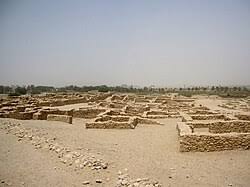Dilmun Civilization:

Kuwait’s Failaka Island has just yielded one of its most significant secrets in decades: a 4,000-year-old temple belonging to the powerful Bronze Age Dilmun civilization.
- Dilmun Civilization was a civilization located in the eastern part of the Arabian Peninsula.
- Dilmun was mainly located on the islands of Bahrain and Failaka Island in Kuwait.
- It also had a presence in parts of Saudi Arabia, Qatar, Oman, and the nearby Iranian coast in the Persian Gulf.
- Although this was quite an old civilization, it is much less famous than the four cradles of civilization of the Old World,e., Mesopotamia, Ancient Egypt, the Indus Valley Civilization, and the Yellow River Civilization.
- The Dilmun civilization first took shape towards the end of the 4th millennium BCE, around 3200 to 3000 BCE, starting out as a modest trading hub.
- By the early 3rd millennium BCE, it had grown into a recognised power in the region.
- Dilmun acted as a central point for trade between two of the biggest ancient civilizations: Mesopotamia (modern-day Iraq) and the Indus Valley Civilization (modern-day Pakistan and India).
- Goods like copper, pearls, and other materials passed through Dilmun. This made it a rich and powerful place.
- One of Dilmun’s most important roles was providing copper. Copper was a vital metal in the Bronze Age, used for tools, weapons, and art.
- Dilmun helped supply this important metal to Mesopotamia, which needed it for its growing cities and armies.
- After 1600 BCE, the empire began to dwindle, then slowly declined like many other empires.
- It was eventually absorbed into Mesopotamia and Persia at a later date.
- Archaeologists have found many ancient sites in Bahrain and Kuwait that match the descriptions of Dilmun.
- These sites include old settlements, burial mounds, and artifacts like unique stamp seals.




